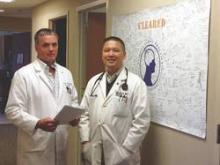The Fairfax Family Practice Comprehensive Concussion Center is an example of what dedicated physicians can accomplish when they undertake to improve upon an accepted medical approach to a health problem because it falls far short of effective. The concussion center’s hall wall is adorned with a broad and colorful sign autographed by scores of patients – many of them student-athletes – who have been cleared to return to their sports and activities and to lives free of restrictions and struggle following concussion.
Dr. Garry W.K. Ho, the double-credentialed family practice and sports medicine physician who directs the 2-year-old concussion center in Fairfax, Va., takes pride in the skills his team has acquired to facilitate these recoveries.
He and his colleagues within the practice’s sports medicine division established the center, teaming up with several certified athletic trainers, to meet what they saw as a growing, urgent need: to help concussed patients who were taking longer than the oft-mentioned 7-10 days or 2 weeks to heal.
“While many of the people we’d been treating in the clinic with typical 15- to 30-minute appointments and relatively simple follow-up were able to get better, there was clearly a subset of the population that was more complicated and needed a more dedicated, multidimensional approach,” Dr. Ho said.
Findings from a growing number of studies have shown that concussions can involve a vast array of deficits – problems with the vestibular and vision systems, for example – and that a more comprehensive initial evaluation and a multipronged approach to management could shorten recovery time for any individual with the brain injury, he said.
“We’d started to realize how much patients can benefit from new and creative approaches,” said Dr. Ho. “We were also appreciating that no one person can own this disorder. You can’t say that only the neurologist can treat a concussion, or only the family physician or sports medicine physician.
‘Silent epidemic’
A small but growing number of concussion-care programs and clinics are being established across the country. Most often, the programs are incorporated into hospitals and sports medicine clinics. But some, like the program Dr. Ho leads, are embedded within larger primary care practices with a sports medicine component.
And, in other traditional family practices, some physicians are deepening their knowledge of concussions and building the networks necessary for managing prolonged impairment.
“If we have a good understanding of brain injury, we can often facilitate recovery and help [our patients] get back on track seamlessly,” said Dr. Rebecca Jaffe, a family physician in Wilmington, Del. “And when recovery is protracted, when issues don’t resolve in 2-3 weeks, there’s often more to the situation than is initially apparent, and it’s often better that we have a team of individuals who can help us.”
According to the Institute of Medicine (IOM), there are not enough data for an accurate estimate of the incidence of sports-related concussions in youth (Institute of Medicine and National Research Council. 2014. Sports-related concussions in youth: Improving the science, changing the culture. Washington, D.C.: The National Academies Press.)
But among high school athletes, an increase in concussions has been documented in several emergency department studies and other longitudinal studies published over the past 7-8 years. Most recently, the first national study to look at trends among high school athletes showed the numbers of concussions reported by certified athletic trainers increasing from 0.23/1,000 athlete-exposures in the 2005-2006 academic year to 0.51/1,000 in the 2011-2012 academic year (Am. J. Sports Med. 2014;42:1710-5).
Experts attribute such increases largely to improved awareness and new state laws. The Centers for Disease Control and Prevention’s launched its “Heads Up” educational program in 2004, for instance. And as of last year, every state and the District of Columbia had enacted at least one law to protect young athletes with concussions.
State concussion laws vary, but most require that parents, athletes, and coaches be educated about concussions, and that athletes with suspected concussions be evaluated and cleared by a health care professional with knowledge in concussions before returning to play.
It is likely, some experts say, that the upward curve is leveling off with improved awareness and diagnosis. But with such improvements there lurks a void of data on concussions in youth outside the realm of high school sports. And, according to the 2014 IOM report, the acute and long-term health threat from concussions is “not fully appreciated or acted upon” in many settings. “Kids are getting removed from play more frequently, but then it’s not really clear what anyone should do after that,” said Dr. Shireen Atabaki, an emergency medicine specialist at Children’s National Medical Center in Washington, who is leading several national initiatives to improve concussion care.

